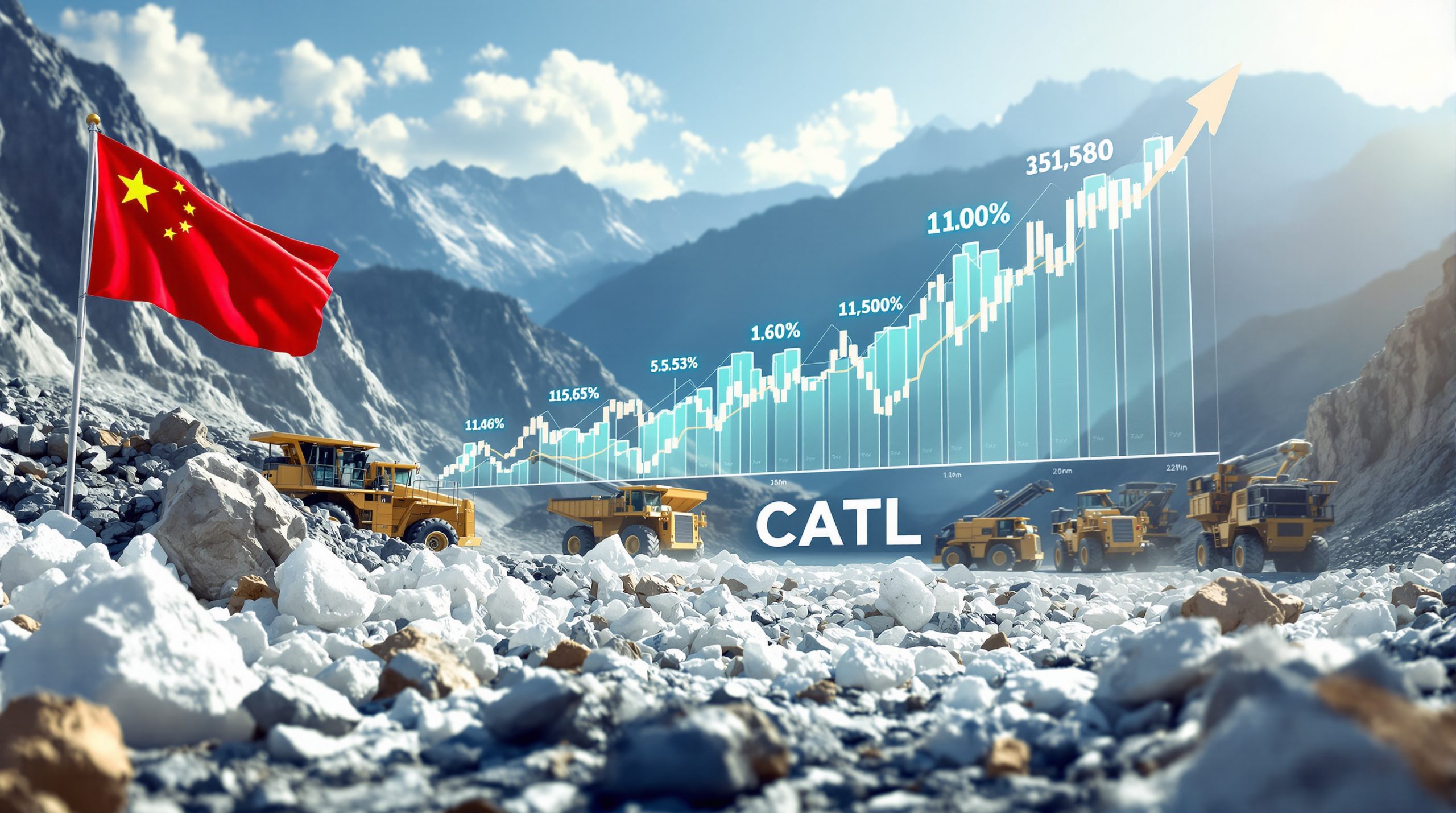Why Is the BHP Share Price Worth Considering for Your Portfolio?
With BHP Group Ltd standing as Australia's largest mining company, investors have good reason to examine its potential as a portfolio addition. The resources giant has shown remarkable resilience despite the inherent volatility in commodity markets, presenting several compelling attributes worth consideration.
Recent Performance Context
BHP's share price has demonstrated positive momentum, climbing more than 10% since late June 2025. Currently trading in the mid-range of its five-year price band, the stock offers a balanced entry point for potential investors—neither presenting as a deep-value bargain nor as an overvalued proposition.
From a cyclical valuation perspective, this mid-range positioning suggests neutral momentum that avoids both overbought and oversold extremes, providing investors with a relatively stable entry opportunity.
"BHP's diversified portfolio provides an effective buffer against commodity cycles, making it a core holding for investors seeking long-term resources exposure without excessive volatility." – Mining sector analysts, 2025
How Is BHP's Copper Production Transforming Its Future?
Record-Breaking Copper Output
BHP has achieved remarkable success in its copper operations, reporting record group production exceeding 2 million tonnes in FY25, representing an impressive 8% year-over-year increase. This exceptional performance was driven by several key operational achievements:
- 16% production increase at the Escondida mine in Chile
- Record output at the Spence operation
- All-time high quarterly production from copper SA assets in Q4
Escondida's substantial growth can be attributed to BHP's access to higher-grade ore bodies combined with the implementation of autonomous drilling technologies that have optimized extraction efficiency. Recent copper market insights suggest the timing of this production increase couldn't be better positioned.
Strategic Importance of Copper
"Copper is the metal of electrification… BHP's output surge aligns precisely with global decarbonization timelines." – Mike Henry, BHP CEO
The red metal's significance to BHP's future cannot be overstated. Copper serves as a critical component in numerous growth sectors:
- Expanding electrical grid infrastructure – requiring approximately 5,500kg of copper per kilometer of transmission line
- Electric vehicle manufacturing – with each EV using 2-4 times more copper than conventional vehicles
- Renewable energy projects – particularly wind farms, which use up to 3 tonnes of copper per megawatt
- Global electrification initiatives – supporting the energy transition worldwide
Perhaps most telling is that a single tonne of copper can power approximately 100,000 EV batteries, according to the International Copper Association (2024). With global copper demand projected to grow at a 5.1% CAGR between 2025-2030 according to CRU Group forecasts, BHP's strategic emphasis on copper production positions the company exceptionally well to capitalize on these trends.
Why Does BHP's Iron Ore Business Remain a Core Strength?
Achieving Production Excellence
While copper represents BHP's future growth engine, iron ore remains its primary profit generator. The company has demonstrated remarkable operational excellence in this segment, highlighted by several key achievements:
- Record iron ore production of 290 million tonnes (100% basis) from Western Australian operations
- Successful navigation of weather disruptions, including Tropical Cyclone Zelia and Tropical Storm Sean in Q3 FY25
- Ahead-of-schedule ramp-up of the second concentrator at Samarco
Most impressively, BHP's sophisticated weather prediction systems and enhanced logistics networks allowed the company to limit production losses during Cyclone Zelia to less than 5% of quarterly output, significantly outperforming the industry average of approximately 15% losses during similar weather events.
The Samarco concentrator ramp-up benefited from BHP's implementation of predictive maintenance AI systems, which identified potential equipment failures before they occurred, accelerating timeline delivery.
Favorable Market Conditions
While BHP cannot control iron ore prices, the current market environment remains supportive of healthy profit margins. Iron ore prices hovering around US$97 per tonne provide a solid foundation for BHP to generate substantial cash flow, with the commodity trading within a 52-week range of US$73–$121 per tonne.
This price stability, combined with BHP's operational efficiency, creates a powerful financial engine that funds both shareholder returns and strategic growth initiatives in other segments like copper. Recent iron ore trends further support this positive outlook for BHP's core business.
How Is China's Economic Resilience Benefiting BHP?
China represents BHP's most crucial customer base, making the Asian nation's economic health vital for the miner's financial outlook. Despite persistent concerns about China's property sector, BHP has observed remarkable resilience in the broader Chinese economy.
Sustained Demand From Key Market
The Chinese economic landscape continues to support robust commodity demand through several key channels:
- Expansion of overall export capabilities despite reduced exports to the United States
- Robust domestic consumption maintaining momentum despite property sector challenges
- Strong copper and steel demand driven by accelerated renewable energy investments exceeding 20% year-over-year growth
- Significant electricity grid development through State Grid Corporation's ¥2 trillion expansion plan (2025-2030)
- Healthy machinery export volumes supporting steel consumption
- Continued growth in electric vehicle sales maintaining over 20% annual growth rates
"China's grid build-out and machinery exports have effectively offset property sector slowdowns, creating stable commodity demand patterns that benefit our diverse portfolio." – Mike Henry, BHP CEO
Future Growth Catalysts
BHP's leadership has highlighted China's upcoming 15th 5-year plan as a potential source of policy clarity that could further support longer-term growth and development. Expected in Q4 2025, this comprehensive policy framework will likely prioritize grid modernization according to early drafts from China's National Development and Reform Commission.
This infrastructure focus aligns perfectly with BHP's strategic emphasis on copper production, potentially creating additional tailwinds for the company's operations and share price performance in coming years. The ongoing global trade impact will be crucial to monitor as these developments unfold.
What Risks Should Investors Consider?
While the investment case for BHP appears compelling, prudent investors should maintain awareness of several risk factors that could impact performance.
Market Volatility Factors
The resources sector inherently carries specific challenges that warrant careful consideration:
- Commodity price volatility can significantly impact profitability, with iron ore's 52-week trading range of US$73–$121 demonstrating the potential for substantial swings
- China's economic growth trajectory remains subject to uncertainty, with IMF projections showing a deceleration to 4.2% GDP growth in 2025 compared to 5.1% in 2024
- Global trade tensions could disrupt supply chains and demand patterns, particularly affecting seaborne iron ore routes
- Cyclical nature of mining businesses can lead to share price fluctuations independent of company-specific performance
Historical precedent illustrates these risks clearly—the 2019 Vale dam failure in Brazil caused iron ore prices to spike 30% in just three months, demonstrating how quickly supply disruptions can reshape market dynamics.
Balanced Perspective
Despite these challenges, BHP's diversified portfolio, operational excellence, and strategic positioning in key commodities like copper and iron ore provide a degree of resilience that may help weather market turbulence better than many peers.
The company's strong balance sheet, with a debt-to-equity ratio of 35% compared to the sector average of 48%, provides additional financial flexibility to navigate downturns while continuing to invest in growth opportunities.
How Does BHP Compare to Other ASX Mining Stocks?
Competitive Advantages
As the largest ASX mining share with a market capitalization of approximately A$220 billion (substantially exceeding Rio Tinto at A$185 billion and Fortescue at A$75 billion), BHP offers several structural advantages compared to smaller competitors:
- Greater operational diversification across commodities and geographies
- Stronger balance sheet to withstand market downturns
- Economies of scale in production and logistics
- Established relationships with major customers globally
BHP's 2025 revenue mix demonstrates this diversification in action, with iron ore contributing approximately 55%, copper 25%, and coal/nickel/potash making up the remaining 20%—a more balanced portfolio than many peers who remain heavily concentrated in a single commodity.
Investment Considerations
"BHP's potash and nickel projects provide optionality beyond iron ore, unlike many pure-play peers in the resources sector." – Mining sector analysts, 2025
The company's ambitious Jansen potash project in Canada, scheduled for 2027 startup, aims to capture 20% of the global potash market—illustrating BHP's commitment to developing new growth vectors beyond traditional mining activities.
These structural advantages position BHP as a potentially more stable investment option within the volatile resources sector, particularly for investors seeking exposure to mining with a preference for established operators with proven track records of navigating commodity cycles. The ongoing mining industry evolution further strengthens BHP's competitive positioning.
What Could Drive BHP's Share Price Higher?
Looking ahead, several factors could contribute to positive momentum in BHP's share price, providing potential upside for investors willing to take a medium to long-term perspective.
Growth Catalysts
Key drivers that could propel BHP's market valuation include:
- Continued expansion of copper production amid growing global demand, with analysts projecting copper demand growth at a 5.1% CAGR between 2025-2030
- Sustained operational excellence in iron ore operations, maintaining cost advantages over competitors
- Resilient commodity prices, particularly for copper and iron ore
- Stable or improving economic conditions in China, especially as the country adds an estimated 280 GW of solar and wind capacity by 2027
- Potential benefits from China's policy initiatives, particularly the 15th 5-year plan expected in Q4 2025
BHP's Oak Dam copper discovery in South Australia, with inferred resources of approximately 1.4 million tonnes of copper, represents another potential catalyst as development progresses. This project could significantly expand the company's copper production capability in a jurisdiction with lower geopolitical risk than many competing projects.
Long-Term Outlook
While dramatic short-term share price appreciation may be limited by the cyclical nature of the resources sector, BHP appears well-positioned to deliver solid shareholder returns through a combination of capital appreciation and dividend payments over the longer term.
The company's strategic focus on commodities essential to the global energy transition, particularly copper, aligns with secular growth trends that may provide structural tailwinds for years to come. According to Motley Fool Australia, current price levels present an attractive entry point for long-term investors.
FAQ: Common Questions About BHP Shares
Is BHP primarily an iron ore company?
While iron ore has historically been BHP's largest profit contributor (currently representing approximately 55% of revenue), the company has deliberately cultivated a diversified portfolio that includes significant copper, coal, nickel, and potash assets. The growing importance of copper in BHP's production mix represents a strategic shift toward future-focused commodities essential for global electrification and decarbonization efforts.
How does BHP's dividend policy work?
BHP typically returns a significant portion of its profits to shareholders through dividends, with a payout ratio target of 60-80% of underlying earnings. The company's dividend payments can fluctuate based on commodity prices and overall financial performance, making it both an income and growth investment option.
This "through-cycle" approach aims to provide sustainable shareholder returns while maintaining financial flexibility. Historical precedent demonstrates this variability, with FY24 dividends reduced to A$1.40 per share (from A$3.25 previously) during an iron ore price trough.
What sets BHP apart from other major mining companies?
BHP's scale, operational excellence, and strategic focus on commodities essential for the global energy transition distinguish it from many competitors. The company's strong balance sheet and diversified asset base provide resilience through commodity price cycles, while its leading position in both traditional (iron ore) and future-focused (copper) commodities offers investors exposure to both current cash flow and long-term growth potential.
How sensitive is BHP to changes in the Chinese economy?
As China represents BHP's largest market, particularly for iron ore, the company's financial performance is closely tied to Chinese economic conditions. However, BHP's increasing diversification into copper and other commodities helps mitigate some of this concentration risk.
Sensitivity analysis suggests that a 10% drop in iron ore prices reduces BHP's earnings per share by approximately 15%, illustrating the company's exposure to Chinese steel production trends. However, the company's diversification strategy and focus on copper partially offset this dependence, providing some buffer against China-specific economic fluctuations. Recent mineral exploration insights further highlight the importance of BHP's diversification strategy.
Further Exploration
Investors interested in learning more about BHP and ASX mining shares can explore additional perspectives on BHP's investment potential through resources like Rask Media's analysis to gain broader market context on this compelling resources giant.
Disclaimer: This article contains general investment information and should not be considered personalized financial advice. Commodity markets and mining shares can be volatile, and past performance is not indicative of future results. Investors should conduct their own research or consult a financial advisor before making investment decisions.
Ready to Spot the Next Major Mineral Discovery?
Don't miss breakthrough ASX mineral announcements that could transform your portfolio! Explore how Discovery Alert's proprietary Discovery IQ model delivers real-time alerts on significant discoveries, giving you an immediate market edge at https://discoveryalert.com.au/discoveries/.




